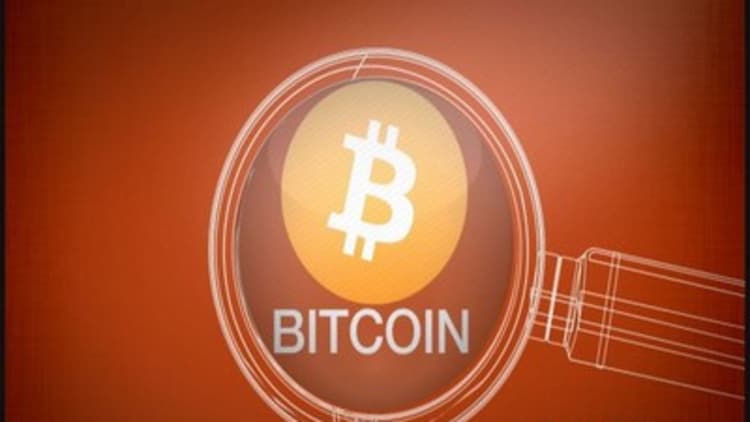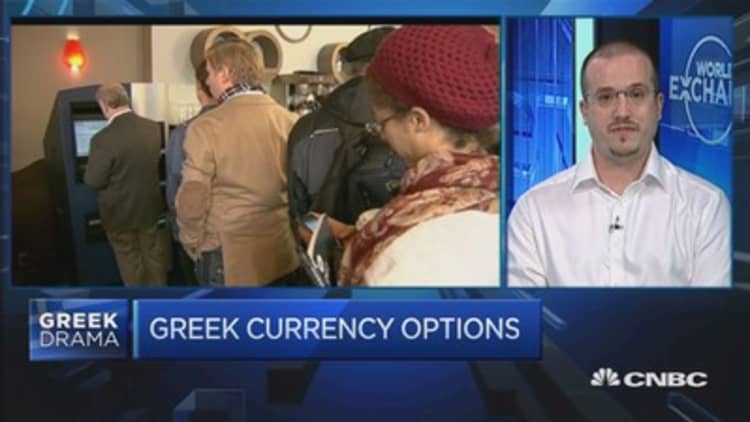With a market valued currently at more than $3 billion, and hundreds of millions invested in related technologies, a lot is riding on bitcoin. But the digital token some say could replace government-backed currencies is facing a crisis that experts warn could potentially render it worthless.
Over the weekend, two well-known bitcoin developers "forked" the technology, releasing software that will allow the community to split away from the core program. This contentious split arose over a long-running squabble between developers that started as a disagreement about the way data is packaged, and morphed into a philosophical question about the future of the technology.
That very future—as CNBC predicted in July—could conceivably be threatened by the new software—called Bitcoin XT.
"Contentious hard forks are bad for Bitcoin," the semi-official site Bitcoin.org's David Harding wrote in a policy post. A "hard" fork such as XT is not backwards-compatible with other versions of the software, meaning that any divergence in adoption is more difficult to reconcile.
"At the very best, a contentious hard fork will leave people who chose the losing side of the fork feeling disenfranchised. At the very worst, it will make bitcoins permanently lose their value. In between are many possible outcomes, but none of them are good," the post continued.
Here's the gist of the squabble: Bitcoin transactions are packaged into blocks before being recorded on bitcoin's permanent ledger. Developers disagree over what the maximum size of those blocks should be. On one hand, smaller means more security, but on the other hand bigger means that bitcoin technology can more easily scale into wider adoption and noncurrency applications.
And beyond just the technical matter, the fight comes down to a more human dilemma: Who gets to decide which way the whole community, which is effectively leaderless, has to go?
Mike Hearn, one of the developers behind XT, wrote in a lengthy post explaining the fork that the current limitations of the original software are blocking the growth of bitcoin and its blockchain currency. He disputed Bitcoin.org's assessment of worst-case scenarios, and said that the fork may be the best way to save the currency from becoming irrelevant.
Read MoreThe details of the debate can be found here.
"There's no reason to believe a hard fork would make bitcoins permanently lose their value. On the contrary, it should increase them, as it'd prove the system is robust against poor decisions by any one group of developers," Hearn said in an email to CNBC. "By asking Bitcoin users to believe that a contentious fork can destroy the system, all they're really saying is that the community must obey the wishes of a tiny group of developers regardless of whether those wishes are bad or not."
The way the XT fork works is that miners (who process transactions by solving complex math problems) can vote for whether they want to switch to the new system or stick with the core program. After Jan. 11, 2016, once 75 percent of mining power is voting for the fork, a two-week waiting period begins, and then the new rules take effect.
Several polls and projections have indicated that miners may favor the primary XT change—making the maximum size for a "block" of data eight megabytes instead of one megabyte—so a fork could be in the future.

Still, several core developers of the technology—who have taken over maintenance and growth of the technology from mysterious creator Satoshi Nakamoto—have come out against the change, and online discussions seem to indicate an ideological split in the community.
Those core developers against the block size increase either did not respond to request for comment from CNBC or denied via a representative.
But Adam Back, who developed one of the key algorithms behind bitcoin and still works with core developers, said the complaints about XT are manyfold, including worries that a 75 percent activation vote is too low, and that some of the other changes to the program are not sufficiently secure.
Back said the community is actively working on finding solutions (with developer workshops scheduled) to the block size problem, and that jumping ahead of the normal review system is "a little puzzling" and "kind of disappointing."
One major expert in the community wrote in a Reddit post that XT "represents a somewhat reckless approach, which in the name of advancement shatters existing structures, fragments the community and spins the ecosystem into chaos."
Read MoreBitcoin firm raises $116M, including Qualcomm investment
Hearn, however, told CNBC he thinks that assessment is "completely wrong," and that the XT approach has been debated for month with every objection considered. After all, the development of the potentially world-changing Bitcoin technology has been largely developed without much structure, he said.
"You can't shatter something that doesn't exist. Unfortunately a whole lot of people in the bitcoin community who aren't [closely] involved haven't fully realized or accepted how ad-hoc the Bitcoin Core project truly is," Hearn said, adding that "underlying contradictions and inability to make decisions" are actually the major problems that XT seeks to address.
Hearn's desire to alter the decision-making process behind bitcoin would see him and XT co-developer Gavin Andresen jointly managing the technology, rather than a group of developers. Back acknowledged that the emergence of XT partially stems from resentment about other developers' ideas being shot down, but he said he believed a distributed power structure works best.
"It's intentionally a decentralized process. People are worried that with $4 billion on the line someone could be blackmailed or could intentionally insert a bug," Back said. "They didn't think about the risks of being the sole maintainer of $4 billion of other people's money.... They're not thinking ahead far enough about the implications for all of this." (The total value of all existing Bitcoins was about $4 billion at the beginning of August; it's closer to $3.4 billion now.)
As for concerns that his actions could spin the multibillion-dollar ecosystem into chaos, Hearn said he is in fact saving the technology.
"[Andresen] and myself have said since the start that Bitcoin is a risky experiment. I'm sure everyone who invested knew that," Hearn wrote. "But if they invested, they presumably invested in the hope that Bitcoin would take off and become really mainstream. Right now, the only way to get there is via Bitcoin XT. So they should consider helping us out to ensure the outcome they would like."
Investor Roger Ver—so-called "Bitcoin Jesus"—is one of several prominent voices in the community to voice his approval of the XT project.
Additionally, a statement from all of the Chinese mining pools—which account for much of the power in the network—came out in favor of a block size increase. Still, Hearn could not say how he thought the community would swing, but underscored his contention that a vote for the core software could stymie future growth.
"Well, Bitcoin will still exist no matter what happens. But obviously if there's no chance of growth and the community decides to follow the Bitcoin Core developers (without even knowing who exactly is in that group), then a whole lot of other developers and entrepreneurs will leave," Hearn said. "Because you can't build a successful business on an infrastructure with no chances of growth."

All of this occurs against a background of increasing corporate and financial interest in bitcoin and its backing blockchain technology.
Bitcoin runs on a blockchain that is more secure and decentralized than any of its competitors because of its large user base and its comparatively lengthy history. If those users were to splinter, then the entire enterprise could be compromised.
Read MoreWhy is it called the 'blockchain?'
Hearn wrote in his explanation of the fork that there are few risks of breaking the community: If less than 75 percent votes for XT, then nothing changes, and if more than 75 percent is in favor, then the rest of the marketplace will follow suit so as not to be left behind.
"We don't think the sky will fall if the chain forks. We think people on the small-blocks side of the chain will upgrade and continue on the bigger-blocks side. There will be plenty of time for them to know about the change and prepare," he wrote.
Still, if a sizable minority decides to hold out against XT and its bigger blocks, then presplit bitcoins could be spent twice—violating one of the key facets of the digital currency, and potentially harming trust.
Back warned that the results of the fork could be disastrous. Anti-XT programs have sprung up to corrupt the vote, so even if it appears that there's been a 75 percent majority, the community could still be split 50-50.
"If you get some kind of 50-50 split," Back explained, "you have two ledgers, not accepting each other's blocks ... inconsistent ledgers and exchanges that were out hundreds of thousands, or millions, of dollars."
"Nobody wants it to go there, but the Bitcoin XT thing is teetering into a dangerous situation and dynamic," he added. "The safest thing to do is to stop that dynamic well before activation."
Jeff Garzik, another bitcoin core developer who has expressed support for bigger blocks, told CNBC in June that creating a contentious fork would be the "worst of all possible options."
As Hearn said in his letter to the community: "So this is it. Here we are."


